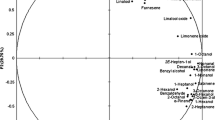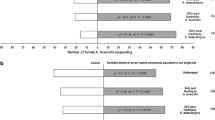Abstract
Bean plants (Vicia faba L. and Phaseolus vulgaris L.) damaged by feeding activity of Nezara viridula (L.) (Heteroptera: Pentatomidae), and onto which an egg mass had been laid, produced volatiles that attracted the egg parasitoid Trissolcus basalis (Wollaston) (Hymenoptera: Scelionidae). Extracts of volatiles of broad bean and French bean plants induced by adults of N. viridula as a result of their feeding activity, oviposition activity, and feeding and oviposition activity combined were analyzed by gas chromatography–mass spectrometry (GC–MS), and tested in Y-tube olfactometer bioassays as attractants for T. basalis females. In extracts from undamaged leguminous plants, green-leaf volatiles were absent or scarcely detected, and monoterpenes and sesquiterpenes were present at trace levels. No significant differences were detected in the profiles of volatiles of undamaged plants, and undamaged plants on which bugs were allowed only to lay eggs. In contrast, feeding and oviposition by adults of N. viridula induced in both leguminous plants a significant increase in terpenoids such as linalool, (E)-β-caryophyllene, (E,E)-4,8,12-trimethyl-1,3,7,11-tridecatetraene, and (3E)-4,8-dimethyl-1,3,7-nonatriene, which was induced only in French bean plants. Quantitative comparisons revealed increased levels of (E)-β-caryophyllene in extracts from feeding-damaged plants with N. viridula egg masses compared to feeding-damaged plants without egg masses. In Y-tube olfactometer bioassays, T. basalis females were attracted by extracts of both leguminous plants only when N. viridula adults were allowed to feed and oviposit upon them. Fractionation of extracts of volatiles from broad bean plants with N. viridula feeding damage and egg masses yielded two fractions, but only the fraction containing (E)-β-caryophyllene was attractive to the egg parasitoid. These findings indicate that N. viridula feeding and oviposition induce leguminous plants to produce blends of volatiles that are characterized by increased amounts of (E)-β-caryophyllene, and these blends attract female T. basalis. The role of (E)-β-caryophyllene as a potential synomone for T. basalis is discussed.
Similar content being viewed by others
REFERENCES
Agelopoulos, N. G., Hooper, A. M., Maniar, S. P., Pickett, J. A., and Wadhams, L. J. 1999. A novel approach for isolation of volatile chemicals released by individual leaves of a plant in situ. J. Chem. Ecol. 25:1411–1425.
Baldwin, I. T. and Preston, C. A. 1999. The eco-physiological complexity of plant responses to insect herbivores. Planta 208:137–145.
Bernasconi, M. L., Turlings, T. C. J., Ambrosetti, L., Bassetti, P., and Dorn, S. 1998. Herbivore-induced emissions of maize volatiles repel the corn leaf aphid, Rhopalosiphum maidis. Entomol. Exp. Appl. 87:133–142.
Bichao, H., Borg-Karlson, A. K., Araujo, J., and Mustaparta, H. 2003. Identification of plant odours activating receptor neurones in the weevil Pissodes notatus F. (Coleoptera, Curculionidae). J. Comp. Physiol. 189:203–212.
Boland, W., Koch, T., Krumm, T., Piel, J., and Jux, A. 1999. Induced biosynthesis of insect semiochemicals in plants, pp. 110–126, in D. J.Chadwick and J. A.Goode (eds.). Insect-Plant Interactions and Induced Plant Defence. Novartis Foundation Symposium 223. Wiley, Chicester, England.
Colazza, S. and Bin, F. 1995. Efficiency of Trissolcus basalis (Hymenoptera: Scelionidae) as an egg parasitoid of Nezara viridula (Heteroptera: Pentatomidae) in central Italy. Environ. Entomol. 24:1703–1707.
Colazza, S., Fucarino, A., Peri, E., Salerno, G., Conti, E., and Bin, F. 2004. Insect oviposition induces volatile emission in herbaceous plants that attracts egg parasitoids. J. Exp. Biol. 207:47–53.
Colazza, S., Cxeri, D., Peri, E., Lo Pinto, M., and Liotta, G. 1999a. A video tracking and motion analysis system for LINUX, in XII Int. Entomoph. Insect Workshop, Asilomar, CA, Sept. 26–30, 1999.
Colazza, S. and Pompanon, F. 1994. Ritmo giornaliero dell'attività locomotoria degli adulti di Trissolcus basalis (Wollaston) (Hymenoptera: Scelionidae), pp. 647–650, in Atti XVII Congr. Naz. It. di Entomol., Udine 13-18 giugno 1994.
Colazza, S., Rosi, M. C., and Clemente, A. 1997. Response of the egg parasitoid Telenomus busseolae to sex pheromone of Sesamia nonagrioides. J. Chem. Ecol. 23:2437–2444.
Colazza, S., Salerno, G., and Wajnberg, E. 1999b. Volatile and contact chemicals released by Nezara viridula (Heteroptera: Pentatomidae) have a kairomonal effect on the egg parasitoid Trissolcus basalis (Hymenoptera: Scelionidae). Biol. Control 16:310–317.
Cortesero, A. M., Stapel, J. O., and Lewis, W. J. 2000. Understanding and manipulating plant attributes to enhance biological control. Biol. Control 17:35–49.
Degenhardt, J., Gershenzon, J., Baldwin, I. T., and Kessler, A. 2003. Attracting friends to feast on foes: engineering terpene emission to make crop plants more attractive to herbivore enemies. Cur. Opin. Biotechnol. 14:169–176.
De Moraes, C. M., Lewis, W. J., Paré, P. W., Alborn, H. T., and Tumlinson, J. H. 1998. Herbivore-infested plants selectively attract parasitoids. Nature 393:570–573.
Dicke, M. 1999. Evolution of induced indirect defense of plant, pp. 62–88, in R. Tollrian and C. D. Harvell (eds.). The Ecology and Evolution of Inducible Defenses. Princeton University Press, Princeton, NJ.
Dicke, M. 2000. Chemical ecology of host-plant selection by herbivorous arthropods: A multitrophic perspective. Biochem. System. Ecol. 28:601–617.
Dicke, M. andvan Loon, J. J. A. 2000. Multi-trophic effects of herbivore-induced plant volatiles in an evolutionary context. Entomol. Exp. Appl. 97:327–249.
Donath, J. and Boland, W. 1995. Biosynthesis of acyclic homoterpenes: Enzyme selectivity and absolute configuration of the nerolidol precursor. Phytochemistry 39:785–790.
Du, Y., Poppy, G. M., Powell, W., Pickett, J. A., Wadhams, L. J., and Woodcock, C. M. 1998. Identification of semiochemicals released during aphid feeding that attract parasitoid Aphidius ervi. J. Chem. Ecol. 24:1355–1368.
Elzen, G. W., Williams, H. J., and Vinson, S. B. 1984. Isolation and identification of cotton synomones mediating searching behavior by parasitoid Campolitis sonorensis. J. Chem. Ecol. 10:1251–11263.
Flint, H. M., Salter, S. S., and Walters, S. 1979. Caryophyllene: An attractant for the green lacewing. Environ. Entomol. 8:1123–1125.
Gäbler, A., Boland, W., Preiss, H., and Simon, H. 1991. Stereochemical studies on homoterpene biosynthesis in higher plants: mechanistic, phylogenetic, and ecological aspects. Helv. Chim. Acta 74:1773–1789.
Gatehouse, J. A. 2002. Plant resistance towards insect herbivores: A dynamic interaction. New Phytol. (Tansley review no. 140) 156:145–169.
Gouinguene, S. P. and Turlings, T. C. J. 2002. The effects of abiotic factors on induced volatile emissions in corn plants. Plant Physiol. 129:1296–1307.
Guerrieri, E., Poppy, G. M., Powell, W., Tremblay, E., and Pennachio, F. 1999. Induction and systemic release of herbivore-induced plant volatiles mediating in-flight orientation of Aphidius ervi. J. Chem. Ecol. 25:1247–1261.
Hilker, M., Kobs, C., Varama, M., and Schrank, K. 2002b. Insect egg deposition induces Pinus to attract egg parasitoids. J. Exp. Biol. 205:455–461.
Hilker, M. and Meiners, T. 2002. Induction of plant responses to oviposition and feeding by herbivorous arthropods: A comparison. Entomol. Exp. Appl. 104:181–192.
Hilker, M., Rohfritsch, O., and Meiners, T. 2002a. The plant's response towards insect egg deposition, pp. 205–233, in M.Hilker and T.Meiners (eds.). Chemoecology of Insect Eggs and Egg Deposition. Blackwell, Berlin.
Jones, W. A. 1988. World review of the parasitoids of the southern green stink bug, Nezara viridula (L.). Ann. Entomol. Soc. Am. 81:262–273.
Karban, R. and Baldwin, I. T. 1997. Induced Responses to Herbivory. The University Press of Chicago, Chicago.
Mattiacci, L., Vinson, S. B., Williams, H. J., Aldrich, J. R., and Bin, F. 1993. A long-range attractant kairomone for the egg parasitoid Trissolcus basalis, isolated from defensive secretion of its host, Nezara viridula. J. Chem. Ecol. 19:1167–1181.
Meiners, T. and Hilker, M. 2000. Induction of plant synomones by oviposition of a phytophagous insect. J. Chem. Ecol. 26:221–232.
Mumm, R., Schrank, K., Wegener, R., Schulz, S., and Hilker, M. 2003. Chemical analysis of volatiles emitted by Pinus sylvestris after induction by insect oviposition. J. Chem. Ecol. 29:1235–1252.
Paré, P. W. and Tumlinson, J. H. 1997. De novo biosynthesis of volatiles induced by insect herbivory in cotton plants. Plant Physiol. 114:1161–1167.
Paré, P. W. and Tumlinson, J. H. 1999. Plant volatiles as a defense against insect herbivores. Plant Physiol. 121:325–332.
Potting, R. P. J., Vet, L. E. M., and Dicke, M. 1995. Host microhabitat location by the stemborer parasitoid Cotesia flavipes: The role of locally and systemically induced plant volatiles. J. Chem. Ecol. 21:525–539.
Rodriguez-Saona, C., Crafts-Brandner, S., Williams, L.,III, and Paré, P. W. 2002. Lygus hesperus feeding and salivary gland extracts induce volatile emission in plants. J. Chem. Ecol. 28:1733–1747.
SPSS Inc. 2001. SPSS for Windows, Standard Version. SPSS Inc. Wacker Drive, Chicago.
Steinberg, S., Dicke, M., and Vet, L. E. M. 1993. Relative importance of infochemicals from first and second trophic level in long-range host location by the larval parasitoid Cotesia glomerata. J. Chem. Ecol. 19:47–59.
Takabayashi, J. and Dicke, M. 1996. Plant-carnivore mutualism through herbivore-induced carnivore attractants. Trends Plant Sci. 1:109–113.
Todd, J. W. 1989. Ecology and behavior of Nezara viridula. Annu. Rev. Entomol. 34:273–292.
Tumlinson, J. H., Lewis, W. J., and Vet, L. E. M. 1993a. How parasitic wasps find their hosts. Sci. Am. 268:100–106.
Tumlinson, J. H., Turlings, T. C. J., and Lewis, W. J. 1993b. Semiochemically mediated foraging behavior in beneficial parasitic insects. Arch. Insect. Biochem. Physiol. 22:385–391.
Turlings, T. C. J. and Benrey, B. 1998. Effects of plant metabolites on the behavior and development of parasitic wasps. Ecoscience 5:3241–3333.
Turlings, T. C. J., Bernasconi, M., Bertossa, R., Bigler, F., Caloz, G., and Dorn, S. 1998. The induction of volatile emissions in maize by three herbivore species with different feeding habits—possible consequences for their natural enemies. Biol. Control 11:122–129.
Turlings, T. C. J., Loughrin, J. H., McCall, P. J., Röse, U. S. R., Lewis, W. J., and Tumlinson, J. H. 1995. How caterpillar-damaged plants protect themselves by attracting parasitic wasps. Proc. Natl. Acad. Sci. U.S.A. 92:4169–4174.
Turlings, T. C. J. and Tumlinson, J. H. 1992. Systemic release of chemical signals by herbivore injured maize. Proc. Natl. Acad. Sci. U.S.A. 89:8399–8402.
Turlings, T. C. J., Tumlinson, J. H., and Lewis, W. J. 1990. Exploitation of herbivore-induced plant odors by host-seeking parasitic wasps. Science 250:1251–1253.
Vinson, S. B. 1985. The behavior of parasitoids, pp. 417-469, in G. A. Kerkut and L. I. Gilbert (eds.). Comprehensive Insect Physiology, Biochemistry, and Pharmacology, vol. 9. Pergamon Press, Elmsford, New York.
Vinson, S. B. 1998. The general host selection behavior of parasitoid Hymenoptera and a comparison of initial strategies utilized by larvaphagous and oophagous species. Biol. Control 11:79–96.
Wegener, R. and Schulz, S. 2002. Identification and synthesis of homoterpenoids emitted from elm leaves after elicitation by beetle eggs. Tetrahedron 58:315–319.
Wegener, R., Schulz, S., Meiners, T., Hadwich, K., and Hilker, M. 2001. Analysis of volatiles induced by oviposition of elm leaf beetle Xanthogaleruca luteola on Ulmus minor. J. Chem. Ecol. 27:499–515.
Author information
Authors and Affiliations
Corresponding author
Rights and permissions
About this article
Cite this article
Colazza, S., McElfresh, J.S. & Millar, J.G. Identification of Volatile Synomones, Induced by Nezara viridula Feeding and Oviposition on Bean spp., That Attract the Egg Parasitoid Trissolcus basalis . J Chem Ecol 30, 945–964 (2004). https://doi.org/10.1023/B:JOEC.0000028460.70584.d1
Issue Date:
DOI: https://doi.org/10.1023/B:JOEC.0000028460.70584.d1




